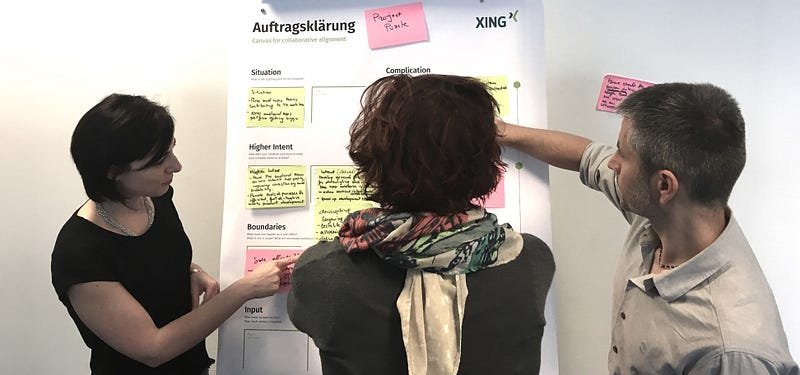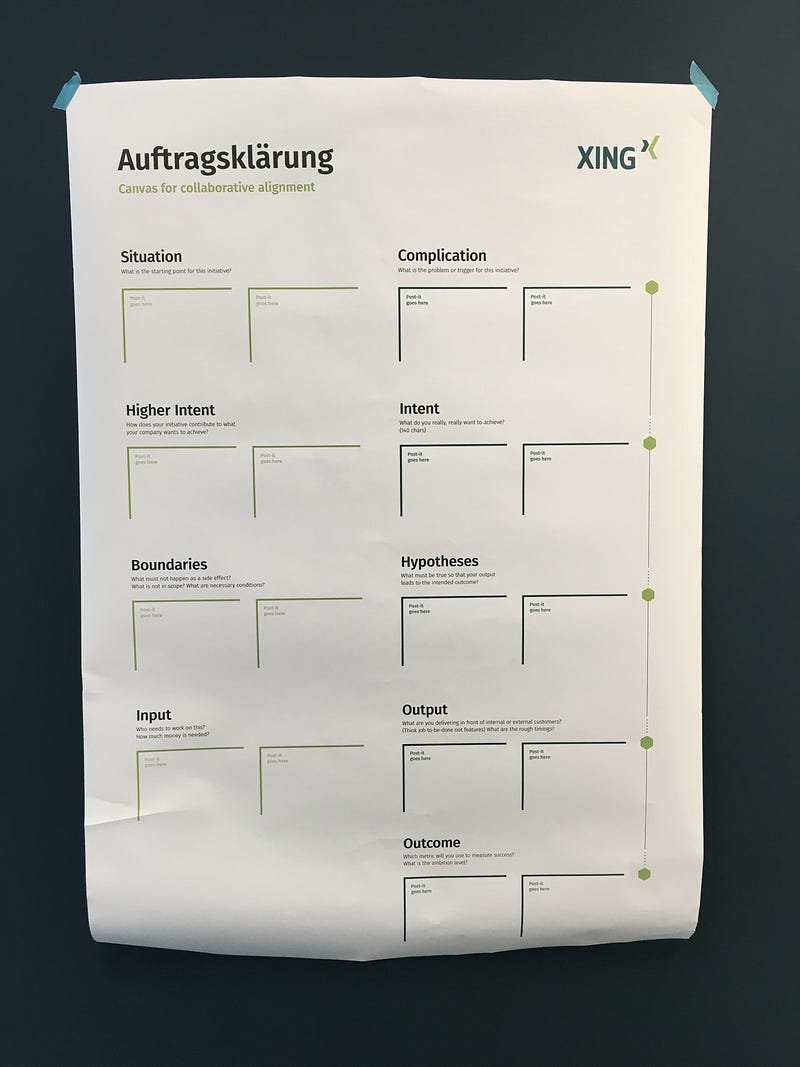Collaborative Alignment for Product Managers
Why product managers need to take the driver seat in getting alignment for their product.
This blog post was initially published on Medium, and is republished here for easier reference. It reflects how we used collaborative alignment back when I was working as a product leader at XING. The Auftragsklärung canvas described here was the first version of the canvas we did - it was later reworked to put more emphasis on the user perspective and apply some other learnings from how it was used at XING and in other organizations.
Auftragsklärung in action
Strong product teams expect a high degree of autonomy in how they build their products. But autonomy is not something you claim — it’s something you can only earn through successful alignment with stakeholders, peers and within your team.
At XING we put product managers in the driver seat for getting alignment about their upcoming initiatives. Learn why this is important and how the Auftragsklärung framework helps to make alignment a collaborative process.
How alignment typically works
Most alignment frameworks focus on alignment as a form of top-down direction — even if the goal is to empower teams. According to authors like Ken Blanchard empowerment must not be misunderstood as „teams can do anything they want“. He emphasizes the need for top management to provide boundaries (purpose, values, goals etc.) in order to create alignment.
Alignment at Spotify: Spotify Rhythm
In the context of digital product management Henrik Kniberg recently also addressed the need for alignment in Spotify’s growing product organization. He describes „Spotify Rhythm“ as their way of creating alignment across the company by prioritizing „bets“ towards Spotify’s North Star goals. These bets are based on an argumentation that makes explicit the underlying data, insights and beliefs. Spotify seem to prioritize them on a company level as well as broken down to tribe-level where they provide additional context for every squad’s (autonomous) decision of how to best make use of their time.
While this approach nicely acknowledges the dynamics and uncertainty of today’s business environment by defining priorities as “bets” (and thus implying that they may fail) its general direction still appears to be somewhat top down and and the product managers in the squads do not seem to play an active role.
Top-down alignment is important — additional bottom-up alignment is better!
Overarching goals, values and priorities help to give product teams orientation. In fact, at XING we also have a clear vision and mission, short- and long-term goals, we defined a North Star for our product management organization and give priority to initiatives we identify as „needle movers“ towards our company goals.
Nevertheless when it comes to creating alignment as a basis for how teams build their product there is value in additional bottom-up alignment driven by the product people in charge of an initiative in collaboration with their cross-functional team, partner teams and stakeholders.
This has the following advantages:
The product managers actively discuss the initiative from various angles. Doing so forces them to go beyond the buzzwords and sharpens their ability to express their real intent. This helps to successfully lead an initiative.
Active dialogue inside the team, with affected partner teams as well as with stakeholders helps to establish a common vocabulary as well as shared expectations for the resulting collaboration.
Everybody who will be contributing to the initiative is aware of their role in the collaboration.
Lastly, actively seeking alignment instead of just translating guidance from superiors creates a stronger sense of ownership for the product managers in charge.
Introducing Auftragsklärung, a framework for collaborative alignment
To support such collaborative bottom-up alignment we developed „Auftragsklärung“ (~ assignment clarification).
With the Auftragsklärung we aim for clarity and alignment about the following aspects of an initiative:
Situation — What’s the starting point for this initiative?
Complication — Why are you acting right now?
Intent — What do you really, really want to achieve?
Higher Intent — How does your initiative contribute to what your company wants to achieve?
Boundaries — What must not happen as a side effect? What’s not in scope?
Hypotheses — What must be true so that your output leads to the intended outcome?
Input — Who needs to work on this? How big is the investment?
Output — What will you deliver in front of internal or external customers?
Outcome — Which metric will you use to measure success? What is the ambition level?
How to use Auftragsklärung
To trigger and support the dialogues necessary to fully benefit from this form of alignment we recently introduced a canvas that we internally use in A1 prints and which you back then many companies also downloaded from a dedicated website we provided (this website is no longer live).
First version of Auftragsklärung canvas
With the canvas we hold workshop sessions of 60–120 minutes with mixed groups of participants during which the product managers will first share their current state of thinking to kick-start the dialogue and then collect and discuss additional views as sticky-notes.
In most cases a series of such workshops is followed by a phase in which the responsible PM writes an 1–2 page summary in A4 or on confluence. Putting the collaborative thoughts into concise writing sharpens clarity of thought and provides a convenient artefact for further alignment rounds with the initial participants or additional stakeholders.
Lastly the resulting completed Auftragsklärung (in text and/or canvas) is used in a kick-off for the actual discovery and development work of the involved product teams.
When to use Auftragsklärung
Auftragsklärung and collaborative bottom-up alignment are especially helpful for product initiatives which require the collaboration of several teams and for initiatives with a lot of (potentially controversial) stakeholder expectations.
In terms of scope the full Auftragsklärung is usually only justified for Epic-sized initiatives. But practicing Auftragsklärung helps to lead more substantial product discussions on a daily basis as well because it becomes more natural to think and talk about intentions, outcomes etc.
While we initially developed Auftragsklärung as a tool for alignment in product management it has since been adopted by other departments and is also used by our C-Level to structure the dialogue around major strategic initiatives.
What’s your experience?
If you ever used Auftragsklärung or applied other ways of creating collaborative alignment I would be curious to hear from you.
And now…. lean back!
My friend & former colleague Marc Kadish back in 2016 gave a presentation on Collaborative Alignment and Auftragsklärung at Product Tank London:

